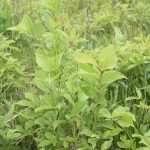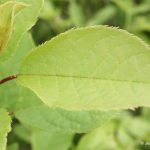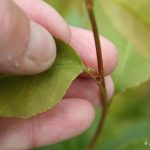Chokecherry
Prepared by Jennifer L. D’Appollonio, Assistant Scientist, University of Maine, Orono, ME 04469. Updated February 2018.
Scientific name: Prunus virginiana L.
Common name(s): chokecherry, choke cherry, common chokecherry
Links: USDA PLANTS Profile, NPIN Profile, Go Botany
Images: (to see enlargements [PC]: click on image, then right click and choose “view image”)
- in pruned blueberry field
- leaf detail showing finely toothed margins and glands at tops of petioles
- stipules
Description:
– woody perennial
– generally flowers in late May-early June in ME
-Shrub or small tree
-can reach 4’-20′ in height
-dark smooth bark with white horizontal lenticels
-Leaves are
- alternate
- oval to lance-shaped
- bright green above, paler below
- sharply toothed
-Flowers are white, in dense clusters 3”-6” long
-Fruit is dark red to black
-Twigs have an undesirably odor when crushed
– may be confused with P. serotina; see left sidebar on Go Botany webpage
Habitat:
Prefers moist rich soils.
-disturbed sites
-forest edges
-meadows and fields
-shrublands
Natural History:
-gets its name from its astringent fruit
Wildlife Benefits:
-the favorite host plant of Eastern tent caterpillars
-birds feed on the fruit
Source(s):
Heinrich, B. 1976. Flowering phenologies: Bog, woodland, and disturbed habitats. Ecology. 57(5):890-899.
Go Botany. “Prunus Virginiana L.” Prunus Virginiana (Choke Cherry): Go Botany, National Sceince Foundation, 2021, gobotany.nativeplanttrust.org/species/prunus/virginiana/.



